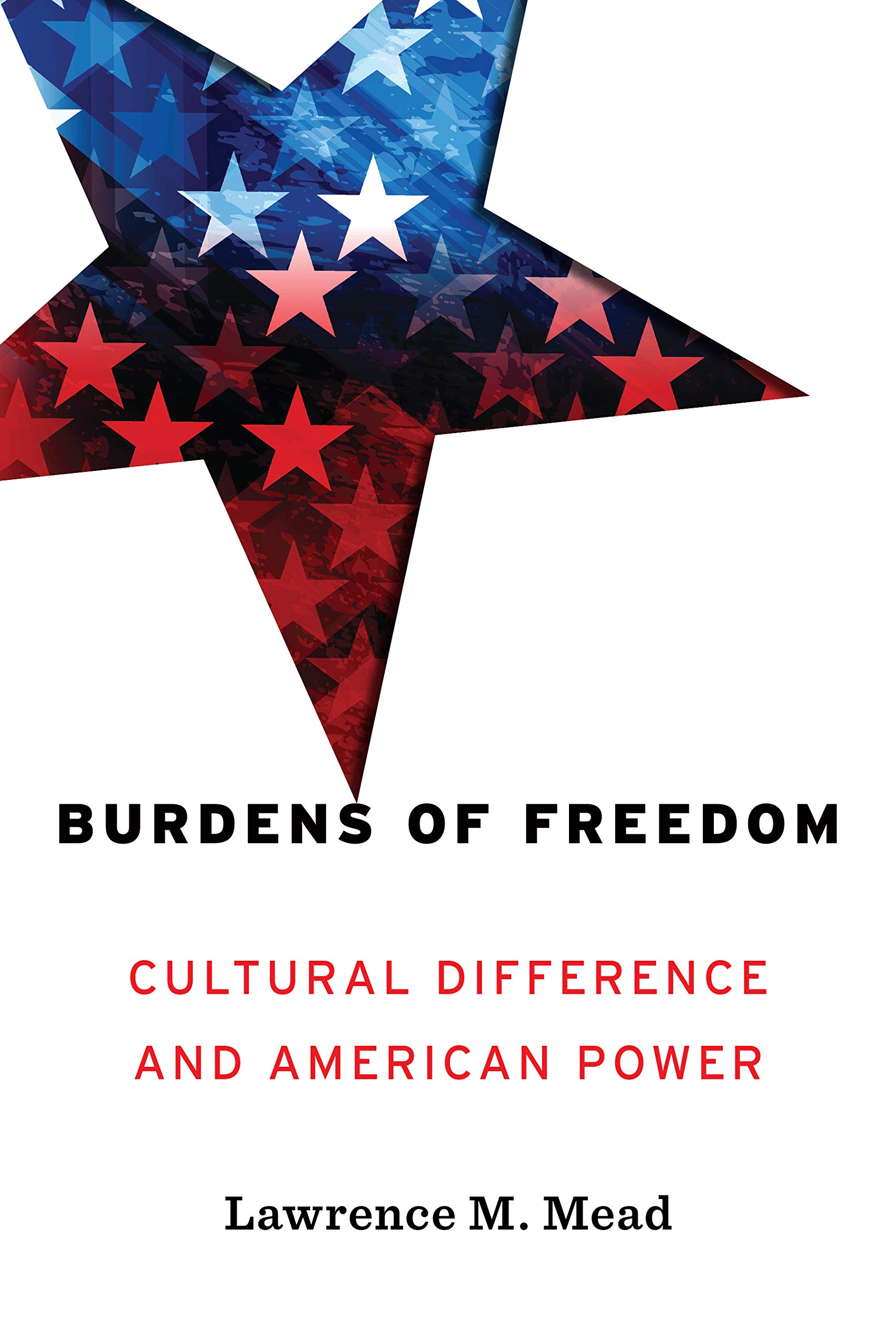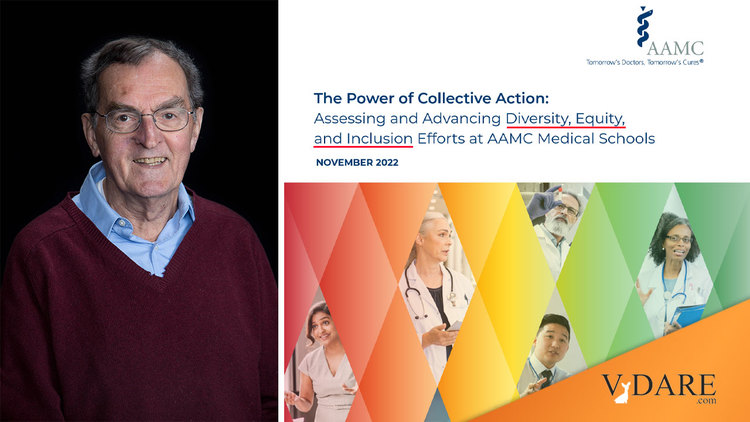Dismantling the meritocracy. I think it was Steve Sailer who first observed that the now-ubiquitous initialism DEI, for "Diversity, Equity, and Inclusion," should more properly be written DIE, as in: "DIE, WHITEY!"
Nowhere is that more apt than in the field of medical education, as we were reminded early in November when the Association of American Medical Colleges (AAMC) extruded a 68-page report on "Assessing and Advancing Diversity, Equity, and Inclusion Efforts at AAMC Medical Schools."
I don't recommend you try reading the report. It's all written in dense Diversperanto jargon (Ctrl-F "holistic"—eleven hits). The excellent Dr. Stanley Goldfarb, co-proprietor of the anti-woke medical website Do No Harm, published a readable summary of the AAMC report in the New York Post.
So how are medical schools most woke? Affirmative action, for one: 100 percent have "admissions policies and practices for encouraging a diverse class of students." Fully 85 percent have leaders who've "used demographic data to promote change" within their institution. In other words, medical schools are giving skin color and gender a consistently bigger emphasis in recruiting. This approach risks de-prioritizing merit, leading to a lower quality of medical students
[Med schools are even more woke than you think—and your care is at risk, by Dr. Stanley Goldfarb; New York Post, November 16, 2022]
De-prioritizing merit, right. (Although Dr. Goldfarb's usage of the weasely "skin color and gender" raised my hackles a millimeter or two. What's wrong with "race and sex"? But this may have been a Post editor substituting his own words for Dr. Goldfarb's.) Why would medical schools want to risk deprioritizing merit? Isn't merit in the practice of medicine, like, … meritorious?
So far as I could discover from further Ctrl-F-ing, the AAMC report sheds no light. Here's a different document that does, though: the American Medical Association's 2021 report "Organizational Strategic Plan to Embed Racial Justice and Advance Health Equity."
This one was 86 pages of Diversibabble. I couldn't face reading it myself, but fortunately Jared Taylor did the job for us at American Renaissance back in September. Jared scraped and bagged the following little deposit from page 12:
The myth of meritocracy … is a narrative that attributes success or failure to individual abilities and merits. It does not address the centuries of unequal treatment that have intentionally robbed entire communities of the vital resources needed to thrive.
[Medicine Goes Dangerously Insane, by Jared Taylor; American Renaissance, September 9 2022]
 The word "dangerously" in Jared's title is not hyperbolic. Third-rate doctoring may kill ya and the DEI cult is pushing third-rate doctors into the profession as fast as it can.
The word "dangerously" in Jared's title is not hyperbolic. Third-rate doctoring may kill ya and the DEI cult is pushing third-rate doctors into the profession as fast as it can.
Dr. Barton Cockey has written about this repeatedly for VDARE.com:
- Dangerous To Your Health: “Antiracism” Infects The American Medical Association
- The Politicization Of Medicine And The Medicalization Of Politics
- Women Are Taking Over Medicine—Not Necessarily Good For Them, Or Their Patients
It's not just medicine.
The American Bar Association voted to drop the LSAT and other standardized tests as requirements for law school admissions.
An ABA panel made its decision on Friday after noon after a committee recommended the testing requirements be scrapped because they hurt diversity in admissions.
The LSAT, or Law School Admission Test, estimates a prospective students [sic] reasoning and reading comprehension, and it serves as a predictor on how they will fair in classes.
The ABA's ruling will take effect in the fall 2025 semester, after a final determination from the association's Hose [sic] of Delegates in February.
[American Bar Association SCRAPS LSAT and standardized admissions tests after woke law schools including Yale and Harvard claimed they hurt diversity, by Ronny Reyes, DailyMail.com, November 18th 2022]
Yes, DEI is mighty in the land. Who dares call it the poisonous gibberish it surely is?
Well, a few gallant souls like Dr. Goldfarb dare. They have no power or money, though, and will be crushed beneath the wheels of the DEI juggernaut. We are dismantling the meritocracy.
Nurturism is Hate. DEI is of course a response to the fact that different races (and sexes, as an afterthought) perform at different statistical levels in different lines of physical, mental, and social endeavor.
Doctoring and lawyering require a lot of book-learning: memorization of many, many complex facts and relationships. The statistics for Ashkenazi Jews and northeast Asians show a big smart fraction who excel at this; blacks show a much smaller smart fraction; whites and Hispanics are intermediate, although more like Asians than blacks. To a first approximation: Asians > whites >> blacks: Rushton's Rule of Three. But what explains the rule?
When these race differences first came to general attention a couple of hundred years ago it was assumed they were natural. Probably that assumption came more easily in societies aristocratic and agricultural, where genealogy and animal breeding were much bigger topics of interest than they became under full democratization and industrialization.
As the human sciences began getting their act properly together in the mid-19th century, an alternative explanation came up. These observed race differences, it said, were caused by external influences operating on a uniform human nature.
By the mid-20th century these two explanations for race differences were being discussed under the heading "Nature versus Nurture." Are the differences innate—natural? Or are they caused by nurture in the broad sense: parenting style, schooling, cultural socialization, class prejudice, the distresses of slavery or household drudgery? The matter was earnestly debated.
In the later decades of the 20th century the "nature" explanation fell seriously out of favor. A few courageous researchers like Rushton soldiered on valiantly seeking explanations from nature, but they labored under obloquy, taboo, censorship, and occasional violence.
By the turn of the century nurturism had triumphed. The other thing—in my book We Are Doomed I called it "biologism," the word "naturism" being already taken—dwelt under a dark, heavy cloud of social disapproval.
For a dozen years or so that remained the state of affairs. Race differences in social or educational outcomes were caused by nurture and other life experiences—by culture. Innate race differences due to biology? Certainly not! Only Nazis and Klansmen believe that stuff.
Then came the Great Awokening of the mid-2010s. One of its consequences, once it had properly settled in as the approved view of human nature, was that nurturism now fell out of favor, following biologism over the cliff onto the rocks of disrepute.
Thus Luana Maroja, Professor of Biology at Williams College, writing at the Common Sense website, November 7th:
Discussing with students how the great variation in human culture affects our behavior and outcomes is now untouchable.
I admit it took me a while to grasp that this had happened. Perhaps my thinking is too doggedly binary. I'd grown up with the nature-nurture debate; nurture had won; nature was banished; end of story. It was the cases of Amy Wax and Larry Mead that opened my eyes.
I had already known U. Penn Law School Professor Wax for some years when I read the op-ed that she cowrote in August 2017 for the Philadelphia Inquirer deploring "the loss of bourgeois habits" and blaming that loss for underclass dysfunction. It was pure nurturism—fix the culture!
All cultures are not equal. Or at least they are not equal in preparing people to be productive in an advanced economy.
[Paying the price for breakdown of the country's bourgeois culture, by Amy Wax and Larry Alexander, Philadelphia Inquirer, August 9, 2017]
Not a trace of biologism. And yet Profs. Wax and Alexander were fiercely attacked for that op-ed and, in Prof. Wax's case, for later similar transgressions, all of an impeccably nurturist color.
 Similarly, I had known New York University Professor Larry Mead for some years when his book Burdens of Freedom: Cultural Difference and American Power came out two years after Prof. Wax's op-ed. Biologism? Not a trace.
Similarly, I had known New York University Professor Larry Mead for some years when his book Burdens of Freedom: Cultural Difference and American Power came out two years after Prof. Wax's op-ed. Biologism? Not a trace.
I attended a private discussion group over the book where Prof. Mead clearly and explicitly declared himself a nurturist. The underperformance of black Americans? "They have to change their approach. They're not thinking straight." I have never, either in private or in public, heard Prof. Mead say anything biologian.
Yet Prof. Mead had walked into the woke propellor too, just as Prof. Wax had. There was a huge fuss over the book and some later articles extracted from it. Prof. Mead lost his NYU classes. (They were given to a black lecturer.)
So forget nature and nurture when seeking explanations for race differences. Biology? Absolutely not! Culture? No way! The only—the one sole, single, only, lone, solitary—thing causing different social outcomes for different races is SYSTEMIC RACISM.
Translation: It's all due to the malice of white people. Write that out a hundred times. If you're caught saying anything else, you'll be expelled from polite society. If you're a college professor, you'll lose your classes.
Ask Prof. Wax and Prof. Mead... who might as well have gone full biologian for all the good their nurturism did them.
chimera \ kī 'mirə … an illusion or fabrication of the mind or fancy; esp a utopian or unrealizable dream or aim. [Webster's Third New International Dictionary, 1993.]
 I miss the old nature/nurture debate. At least it could be conducted intelligently, with reasoned arguments on both sides voiced with proper respect to the rational and empirical disciplines.
I miss the old nature/nurture debate. At least it could be conducted intelligently, with reasoned arguments on both sides voiced with proper respect to the rational and empirical disciplines.
Now that nature and nurture have both been declared to be species of Hate, the discussions of race differences in social outcomes are dumb. There is no math or science in them; indeed, math and science are frowned at as tools of white supremacy. There is just a vocabulary of cuss-words flung about like… well, you know the simile.
This is all in pursuit of a chimera. The name of the chimera is Equity. Your general population is x percent black, or East Asian, or female, or homosexual? Then so should be the proportion in well-paid professions and other positions of prestige; otherwise something is broken and needs mending. We must strive for Equity!
How do we identify and mend what's broken? How do we get Equity?
When we got earnest about the issue half a century ago the loudest answer from social scientists, echoed by politicians, was: "Fix the schools!" Black kids were getting a lousy education, we heard. (Asians hadn't shown up in any quantity at that point.)
There were secondary suggestions too. The kind of written test used to measure suitability for higher education—the SAT and its relatives—were biased, we were told. Regatta! Much labor went into scouring the tests clean of all bias… with barely detectable results.
Then the self-esteem movement had a good run until rigorous research showed that among adolescents, blacks have highest self-esteem, Asians lowest, whites intermediate. Rushton's Rule of Three!—there's no escaping it. "Stereotype Threat" followed a similar trajectory slightly later.
Nothing worked. The explanations put foward explained nothing. Social engineering programs based on those explanations achieved nothing.
To be sure, we are today much closer to Equity in some zones of public life. Here and there we have even overshot the target: the percentage of black faces in TV commercials far, far exceeds thirteen percent. Those are just grace-and-favor zones, though, where people of power have Equity in their gift. Where social outcomes have to pass through any kind of objective meritocratic or legal filter, we are pretty much still where we were in 1972.
Solution: Scrap those filters! Populate upper levels of the meritocracy by quota. That's what our medical and law schools are doing, and our colleges in general.
The Great Enstupidation. Something similar is being done with criminality, the other big area where social outcomes follow Rushton's Rule of Three. As with meritocratic outcomes, we started off what we thought would be a quick march to Equity by working from nurturist explanations: poverty! fatherless families! poor nutrition!
Then… Wait, what? Poor white kids are less likely to go to prison than rich black kids? Uh…
When all nurturist explanations have failed and biologism is undiscussable, where do you end up? On the lecture circuit with Ibram X. Kendi, that's where.
The only remedy to past discrimination is present discrimination.
[How To Be an Antiracist, by Ibram X. Kendi]

Where criminality is concerned, the filter is the criminal justice system. As with academic testing, when biologism has been ruled out of bounds and remedies based on nurturist assumptions have, after decades of trying, delivered results in the tiny-to-nonexistent zone, the only possible path to Equity is to dump the filters. The criminal justice system has to join standardized academic testing in History's garbage can.
This explains those blacks-with-sacks video clips you've seen of shoplifters helping themselves to merchandise in drugstores unchallenged. It also explains the headline events of two years ago: auto dealerships burned out with no arrests while middle-aged demonstrators who strolled through the halls of Congress face what is starting to look like lifetime imprisonment without trial.
Once again: When biologism has been declared beyond the bounds of respectable debate and decades of social engineering premised on nurturist theories have left things well-nigh unchanged, the only explanation you are left with is systemic racism.
Hence the enstupidation of our higher education system on a downward trajectory from actual science (biology) through social "science" (it's the culture!) to Critical Race Theory (white man bad).
What is systemic racism in the minds of Critical Race Theorists, though? What kind of thing do they think it is? Can it be quantified? Subjected to empirical inquiry?
Apparently not. Systemic racism is a thing of some mysterious immaterial kind. I don't think it belongs in the sphere of religion, as John McWhorter has argued. Religion is more substantial and formalized: liturgy, rites, creeds, temples.
Systemic racism, it seems to me, belongs in the realm of magic: of spells and curses, of charms warding off invisible malign forces, of omens and portents, shamans and sacrifices, totems and taboos. Magic is more arbitrary than religion, more primitive and… dumber.
Still, magic has always been a part of human nature and human society, and probably always will be. My daily newspaper, a perfectly respectable organ, publishes daily horoscopes. Here's mine for November 24th:
You may be feeling good about yourself at the moment but you still need to be cautious in certain areas. Be wary of people who flatter you for no good reason—they are obviously looking to feather their own nests, most likely at your expense.
My own attitude to magic is cheerful and tolerant. I even practice a little magic now and then. Homo sum, humani a me nihil alienum puto.
I can't help thinking, though, that magic is a poor foundation for large and complex social enterprises like higher education or criminal justice.
WW1 reflections. November means Veterans' Day, which I grew up hearing called Armistice Day. It of course commemorates the armistice of 11 a.m. on November 11, 1918 that stopped the fighting in World War 1—my Dad's war.
I have written many articles and at least one book review about what the inscription on one of Dad's medals calls The Great War for Civilisation 1914-1919. (The discrepancy in dates occurs because the 1918 armistice was just a cease-fire; the war didn't officially end until the Treaty of Versailles was signed the following June.)
To supplement Dad's stories, and from general interest, I've read a lot about WWI too; but one book I've never read is the 1929 bestselling novel All Quiet on the Western Front by German WW1 veteran Erich Maria Remarque. I did at some point watch the much-acclaimed 1930 movie made from the novel, but retained no strong impression of it.
Prompted by Veterans' Day, our Netflix rental for the November 12th weekend was Edward Berger's 2022 remake of AQOTWF (IWNN in the original German).
Rating from the Derbs: a waste of time. A lot of time—the durnb thing is 2½ hours long. (Checking, I see that this is not that long for a movie. The Godfather was 2h55m; Titanic was 3h14m. All right; but this one seemed long.) Whatever plot there was in the original book has mostly been cut, replaced with endless repetitive drawn-out scenes of mayhem and destruction. Mrs. Derbyshire expressed the unanimous audience verdict about halfway through: "OK, OK, war is hell. We got it."
And I can't leave WW1 without a recommendation of Ron Unz's November 28th "Lost Histories of the Great War" article at The Unz Review. It's prime Unz: argumentative, contrarian, supported by a wealth of documentary evidence. (How does Ron find time to read so much?)
Ron's piece is also a reminder of the awesome complexity of WW1 in its causes, progress, and consequences, with nontrivial input from such improbable places as Ireland and Bulgaria. That's why scholars are still arguing about it. To get a feel for that complexity, and learn about a major What-If you've likely never heard of (I hadn't), read "Lost Histories of the Great War."
Colder dreams, sterner cares. I get asked occasionally—all right, very occasionally, but it just happened—why I no longer express myself in verse, as I was once wont to do (here, here, here, here, etc.)
Pushkin said it better than I can, although audaciously:
The years to solemn prose incline me;
The years chase playful rhyme behind me,
And I—alas, I must confess —
Pursue her now a good deal less.
My pen has lost its disposition
To mar the fleeting page with verse;
For other, colder dreams I nurse,
And sterner cares now seek admission,
And mid the hum and hush of life,
They haunt my soul with dreams of strife.
[Eugene Onegin (tr. Falen); Chapter 6.xliii]
Where is the audacity? Well:
- Those lines occur 72 percent of the way through one of the greatest verse masterpieces in Western literature.
- Eugene Onegin was written in the intimate first person when the poet was not yet thirty. He was only 37 when he died.
Hyponatraemia. November 27th was the birthday of movie martial-arts legend Bruce Lee. My costar would have been 82 years old had he not died in 1973 at age 32.
 The recorded cause of death was cerebral edema—water on the brain. What caused that, though? The controversies here have almost reached origins-of-WW1 levels.
The recorded cause of death was cerebral edema—water on the brain. What caused that, though? The controversies here have almost reached origins-of-WW1 levels.
Until this month the latest theory to register with me was the one in Matthew Polly's biography of Lee, as recorded in the July 13th 2018 edition of Radio Derb. Polly, after studying the matter, concluded that Lee died from heat stroke.
Now here comes the December 2022 issue of Clinical Kidney Journal with a report from a team of nephrologists in Spain. What do they think caused that cerebral edema? Hyponatraemia, that's what. As the report's authors explain, quote:
In other words, we propose that the kidney's inability to excrete excess water killed Bruce Lee. In this regard, Lee had multiple risk factors for hyponatraemia that may have included high chronic fluid intake, factors that acutely increase thirst (marijuana) and factors that decrease the ability of the kidneys to excrete water by either promoting secretion of antidiuretic hormone (ADH) or interfering with water excretion mechanisms in kidney tubules: prescription drugs (diuretics, non-steroidal anti-inflammatory drugs, opioids, antiepileptic drugs), alcohol, chronic low solute intake, a past history of acute kidney injury and exercise.
To put it very simply: The poor guy drank more water than his system could handle. Yes, too much water can kill you: hyponatraemia. Who knew?

Picture: John Derbyshire visited Bruce Lee's Seattle tomb in 2012.
(My VDARE colleague Paul Kersey knew. He told me when we met at the VDARE.com Giving Tuesday Livestream that two acquaintances of his youth, both planning to join the Marine Corps and up for any kind of physical challenge, heard about hyponatraemia somehow and decided to see how much water they could drink. One of them fell quite seriously ill.)
I'll be hearing more about this next month, December. A Hong Kong-based outfit named Infinity Studios has produced a life-size bust of Bruce Lee for sale, in a limited edition, at $4,000. Yes, it's a bust, not a statue: a remarkably lifelike model, but only from the waist up.

Some Bruce Lee fans here—the same ones I reported having had lunch with in my July 2018 Diary—have put in an order for one of these busts. They're having a dinner in its honor at Angela Mao's restaurant in New York City when it arrives at some December date not yet precisely specified. They've invited me and I shall of course be attending. I'll report back in next month's diary.
Math Corner. To make this diary a circle, let's go back to academic testing.
 China has, as is well-known, been doing this for many centuries. How many depends on precise definitions.
China has, as is well-known, been doing this for many centuries. How many depends on precise definitions.
Wisely ignoring what may be called the prehistory of the system—that is, the practice of the Han dynasty (206 B.C.—A.D. 221) of testing men recommended to the emperors—Miyazaki places the beginning of the examination system in the attempt by the Sui emperors (589—618) to assert their authority in the face of the old aristocratic families that had dominated China during the preceding period of disunity. When the short-lived Sui dynasty was succeeded by the T'ang (618—906), the examinations were retained by the new regime and again served as a means for broadening the class background of officialdom. But the system did not really flourish until the Sung period (960—1279), when the old aristocracy no longer existed and rule by civilian bureaucrats was effected. [Conrad Schirokauer in the Introduction to his translation of Ichisada Miyazaki's China's Examination Hell: The Civil Service Examinations of Imperial China (1963)]
(The book's title is not an overstatement. China's Examination Hell makes for grisly reading.)
In line of descent from that old imperial examination system China nowadays has the gāokăo college entrance exam, held every year in June or July. It lasts for nine hours spread over two days. This year more than twelve million high-school seniors sat for the gāokăo. Cheating is illegal, although some brave souls none the less try.
Cheaters could face up to seven years in jail. According to sources, 275 suspects have been arrested for the offense in 2021 alone!
We hear that the gāokăo is ferociously difficult. Looking at some of the math questions just now, though, I thought I would have coped easily with them at age 18. When I said that to Mrs. Derbyshire, however, she jeered at me as a math snob. Eh, maybe.
See what you think. Here, as a brainteaser, is one I took from that last link. (Which, I should warn, includes a worked solution. Don't cheat—it's illegal!)
Four students can choose to participate in a charity event either on Saturday or Sunday but not both. What's the probability that there is at least one student at both Saturday's and Sunday's events? Is it 1/8, 3/8, 5/8, or 7/8?




 John Derbyshire [
John Derbyshire [








